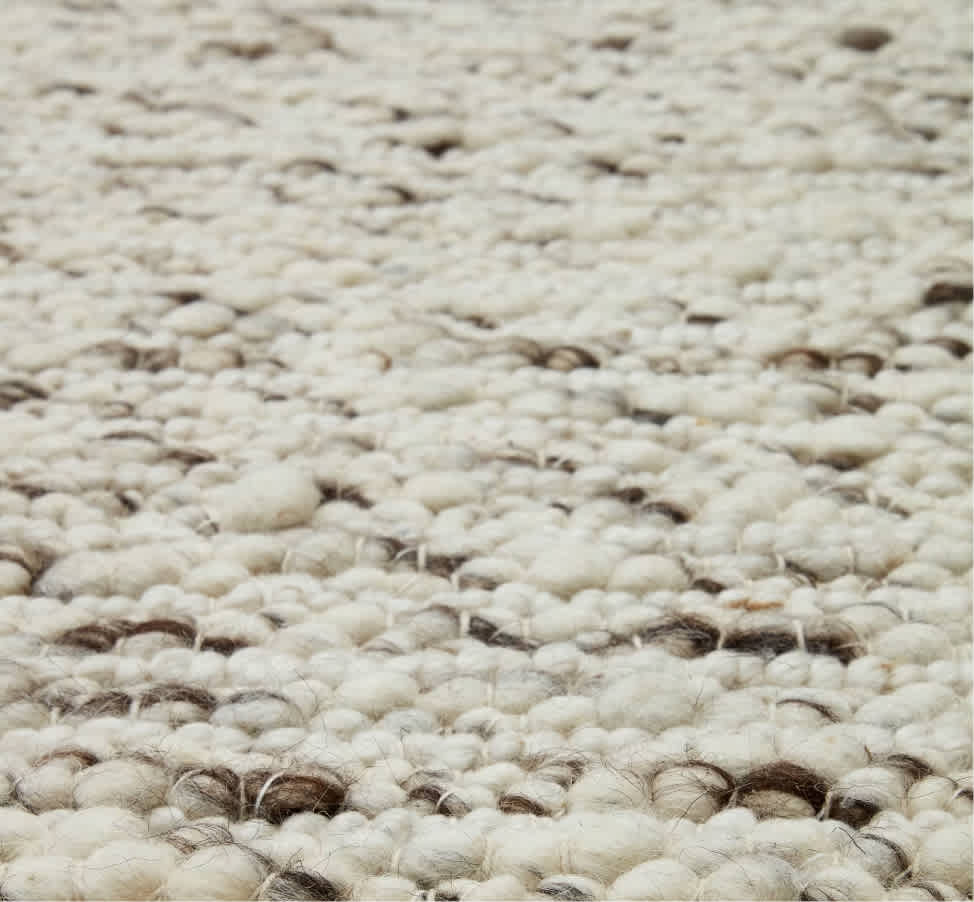Materials:
Fibres for rugs

Plant fibres
Jute, cotton, seagrass, bamboo viscose
Main characteristics
Natural plant fibres are robust and resistant, which guarantees the rug’s long life even in high-traffic areas. Their firm structure and the quality of their yarns make them ideal for spaces requiring durability without sacrificing aesthetics.
In particular, jute and seagrass are biodegradable options that are resource-efficient during production.
How to take care of them
Rugs made with vegetable fibres provide warmth and a unique texture, but require specific care to maintain their beauty and performance.
It is important to protect them from moisture and intense sunlight, as these factors can cause deterioration, discolouration or loss of structure.
We recommend regular vacuuming using a brushless accessory to avoid damaging the fibres. Contact with water may alter them and cause deformation, so only localised dry cleaning is recommended for stains.
Outdoor exposure accelerates wear and the loss of technical and aesthetic properties, so it is advisable to only use it indoors or outdoors under cover.

Wool
100% wool
Main characteristics
Wool stands out for its high resistance and durability, offering a long life even with frequent use and in high-traffic areas. Its composition contains lanolin, a natural oil that protects and nourishes the fibres, helping to maintain their quality and prolonging the life of the fabric.
Wool also naturally adapts to the temperature of the environment: it provides warmth in winter and coolness in summer, ensuring comfort at any time of the year. This thermal regulation capacity, together with its softness and elegant appearance, makes it a versatile and timeless choice for all types of spaces.
How to take care of it
We recommend vacuuming the rug frequently, at least once a week, using moderate power to preserve the integrity of the fibres. Rotating the carpet every 3–6 months helps to prevent areas of localised wear and maintain a uniform appearance.
If you spill liquid on the rug, act quickly to prevent the stain from drying. We recommend cleaning it with a little water, applying it from the edges towards the centre. Before using any products or solutions, test first on an inconspicuous area. In the event of deep cleaning, use a professional dry-cleaning service or use specific products for wool.
Keep out of direct sunlight. Intense exposure can alter its colour; keeping it protected indoors preserves its tone and appearance for much longer.

Wool blends
Wool combined with cotton, polyester, nylon or other fibres
Main characteristics
Rugs made of blends in which wool predominates, combined with cotton, polyester, nylon or other fibres, show less deformation and better shape recovery after use, making them ideal for maintaining their original appearance for longer.
Thanks to the predominance of wool, they retain excellent thermal insulation, providing comfort in both cold and warm climates. This combination of fibres results in a more versatile product that is ready for intensive use, adapting to different styles and needs without losing functionality or aesthetics.
How to care for them
These combined fibres provide resistance, require less maintenance and offer greater adaptability to heavy-use environments.
We recommend vacuuming with moderate power and without a brush to avoid damaging the fibres.
If you spill liquid on the rug, act quickly to prevent the stain from drying. We recommend cleaning it with a little water, applying it from the edges towards the centre. Before using any products or solutions, test first on an inconspicuous area.
For cleaning, opt for professional services or use specific products depending on the secondary component, thus avoiding possible deformations.

Synthetic fibres
Polypropylene, polyester, recycled PET
Main characteristics
Synthetic fibres such as polypropylene, polyester and recycled PET offer high resistance and versatility. Recycled PET is obtained from recycled bottles, giving materials a second life and reducing environmental impact.
They are suitable for wet or outdoor areas. Their resistance to wear and tear makes them an ideal choice for commercial spaces, offices or outdoor areas.
They are perfect for environments with pets due to their ability to withstand potential scratches and intensive play.
As they are non-porous materials, they prevent the accumulation of moisture and the development of mould and mildew, and are treated to protect the colour from wear.
How to care for them
These fibres tolerate heavy cleaning and do not require specialised maintenance.
To prolong the life of the colour and the fibre, we recommend avoiding the use of hot water and corrosive products.